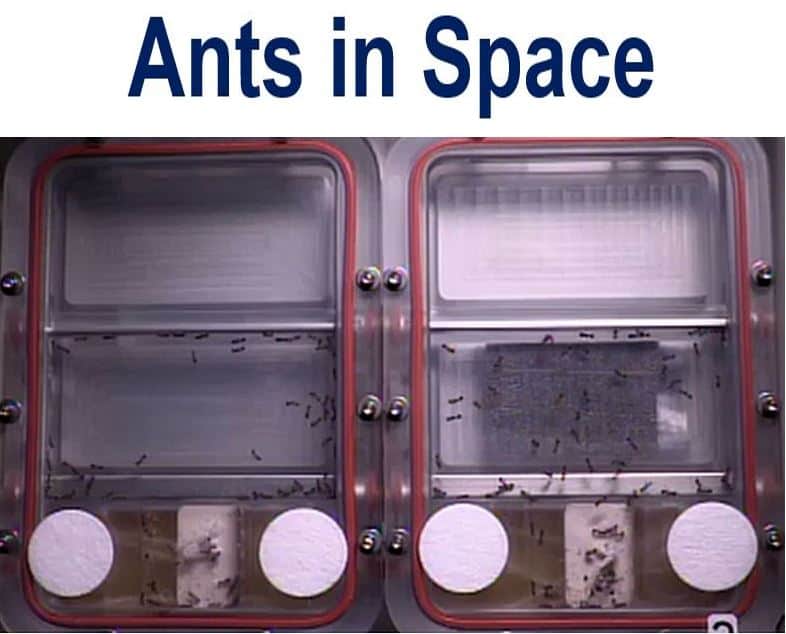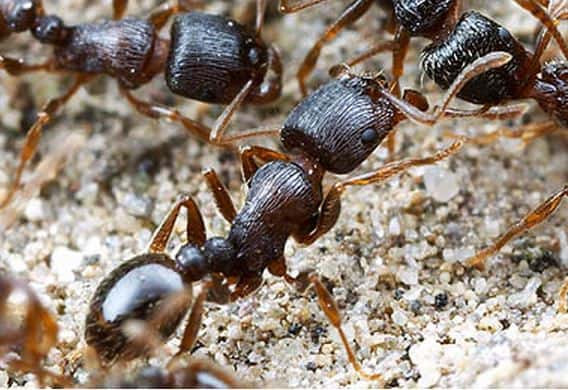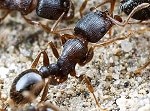Last year some ants were sent into space to see how they would cope in a zero-gravity environment. Today, researchers say that although the insects took longer to explore an area, they coped amazingly well and perceived their space in 3 dimensions.
It did not take them long in their strange environment to learn to work together – they used each other as anchors for exploring and climbing, researchers wrote in the academic journal Frontiers in Ecology and Evolution (citation below).
Despite falling off the walls of their containers for up to eight seconds at a time, the ants still managed to work as a team and search new areas. The biologists informed that their slightly hampered ‘collective search’ still took place.

By analyzing how ants explored these arenas in zero gravity, researchers could develop software that allows autonomous robots to coordinate searches when their radio systems are being disrupted. (Image: Stanford University)
Their ability to regain their footing after taking a zero-gravity tumble and skidding rapidly in a Michael Jackson-type move surprised the researchers. They also showed a remarkable ability to walk on the surface of their enclosure.
The scientists, from the Universities of Colorado (Boulder and Denver), Washington, Stanford, and Utah, as well as AnTracks Computer Vision Systems, want to gain insight into the ants’ cooperative methods and develop search algorithms that can be used for groups of robots.
Video – Ants in zero gravity
Prof. Gordon talks about the experiment with ants in space.
Citizen science project
The team has set up a citizen science lesson plan where schoolchildren can help gather data from other ant species in their classrooms (not in space).
Professor Deborah M. Gordon, from the Department of Biology at Stanford University, who studies collective behavior, says the lesson plan guides students as they investigate new collective search algorithms in ant species that have not yet been studied. She says there are over 14,000 ant species to learn about.
While not encountering microgravity on Earth, ants search in every other kind of environment. The results could offer suggestions on how to program robots for rescue and exploration missions. Rescue robot programs are fed collective search algorithms so that they can search efficiently.
While searching in dangerous territory on behalf of humans, the most effective and cheapest strategy for a robot might be to mimic what ants do, rather than report back to a central controller.
The lesson plan, which was teacher-tested by Tammy Moriarty, a professional development associate at Stanford’s Center to Support Excellence in Teaching, integrates science, technology, engineering and mathematics, known collectively as STEM subjects.

The space experiment was done with Pavement Ants (Tetramorium caespitum).
Exploring with no central control
On Earth, students will investigate the same underlying question Prof. Gordon asked in the Ants-in-Space project: “What techniques can be used to thoroughly explore a novel area, without any central control or plan for how to coordinate the search?”
The project’s data will be available on a public website.
Prof. Gordon said:
“We will compare the results from different species and may learn about some new algorithms for collective search that no one has thought of yet.”
The ISS experiment was done with the pavement ant, (Tetramorium caespitum), an insect native to Europe. The results showed that this type of ant searches by spreading rapidly to the boundary of an area they are exploring. This search algorithm could be the reason for ants frequently ending up in conflict with neighbouring colonies along pavements (US English: sidewalks).
“In the extreme condition of microgravity in space, the pavement ants did the same thing they did on Earth, but not as well,” says Prof. Gordon said.
Many ants do not search the way pavement ants do. “An earlier experiment showed that another species, Argentine ants, do not move toward boundaries. Instead, they search thoroughly all over the new area. Comparing the search behavior of different species can show us how evolution has shaped collective behavior to fit extreme conditions,” Prof. Gordon said.
In the world of ants, there is water, shelter, food and enemies. Ant colonies need to monitor their surroundings to find out what is going on.
Unlike humans, ants do not have access to social media to keep up-to-date on what’s new in their environments. They don’t hold meetings, vote, organize their search, or plan strategies. The majority of ant species do not have good eyesight. They do have an excellent sense of smell.
In order to monitor their colony they have to move around and get up close to things so that they can smell them.
Ants keep up-to-date in diverse ways
Prof. Gordon said:
“Over millions of years of evolution, different ant species have evolved in different environments, and they have probably evolved interesting and diverse ways of keeping track of what is going on.”
Argentine ants, for example, search along a winding path when the environment is crowded, and in straight lines when things are less congested. They know how crowded things are by smelling each other when they touch antennae.
Species that are excellent invaders outside their native habitats, such as the pavement ants and Argentine ants, are probably especially good at searching. Maybe that is why they are so quick to find those grains of sugar on our kitchen counter.
Preparing our future scientists
Moriarty said:
“Deborah Gordon is a scientist who wants to reach out to classroom teachers who are preparing our future scientists and citizens.”
The lesson plan engages schoolchildren with a scientific inquiry that does not have a predictable answer. As a result, they are actually doing science, including gathering and observing wild ants and trying to find patterns in their behaviour.
According to Stanford University:
“Students will use technology, such as cell phone photography or video, to record ant behavior and see how ants go about searching a new area thoroughly. Using affordable and commonly available materials, the students will build an enclosure that allows them to observe ant behavior as the ants explore a new area.”
“Then they will measure the ants’ movements, to see how the ants coordinate their search and how well they cover the area.”
“When student researchers record their results in an online database, the data will be available to other students and scientists.”
Citation: “Collective search by ants in microgravity,” Debora M. Gordon et al. Frontiers in Ecology and Evolution. Published 30 March, 2015. DOI: 10.3389/fevo.2015.00025.
Video – Prof. Gordon’s ant experiment
Prof. Gordon demonstrates a simple ant arena that can be used to conduct the same experiment on collective search that was done on the International Space Station.

